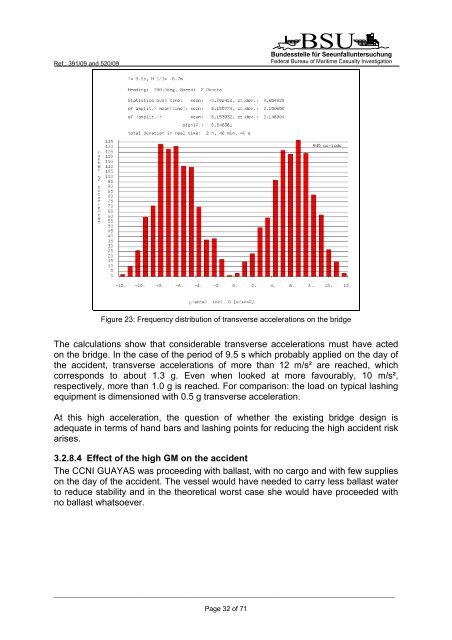SUB-COMMITTEE ON STABILITY AND LOAD LINES AND ON ...
SUB-COMMITTEE ON STABILITY AND LOAD LINES AND ON ...
SUB-COMMITTEE ON STABILITY AND LOAD LINES AND ON ...
Create successful ePaper yourself
Turn your PDF publications into a flip-book with our unique Google optimized e-Paper software.
Ref.: 391/09 and 520/09<br />
BSU<br />
Bundesstelle für Seeunfalluntersuchung<br />
Federal Bureau of Maritime Casualty Investigation<br />
Figure 23: Frequency distribution of transverse accelerations on the bridge<br />
The calculations show that considerable transverse accelerations must have acted<br />
on the bridge. In the case of the period of 9.5 s which probably applied on the day of<br />
the accident, transverse accelerations of more than 12 m/s² are reached, which<br />
corresponds to about 1.3 g. Even when looked at more favourably, 10 m/s²,<br />
respectively, more than 1.0 g is reached. For comparison: the load on typical lashing<br />
equipment is dimensioned with 0.5 g transverse acceleration.<br />
At this high acceleration, the question of whether the existing bridge design is<br />
adequate in terms of hand bars and lashing points for reducing the high accident risk<br />
arises.<br />
3.2.8.4 Effect of the high GM on the accident<br />
The CCNI GUAYAS was proceeding with ballast, with no cargo and with few supplies<br />
on the day of the accident. The vessel would have needed to carry less ballast water<br />
to reduce stability and in the theoretical worst case she would have proceeded with<br />
no ballast whatsoever.<br />
_____________________________________________________________________________________________________<br />
Page 32 of 71
















